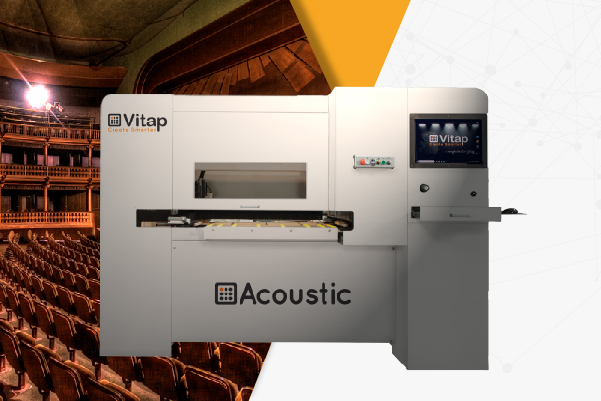
Silence Please: Vitap machines for acoustic panels
Vitap was established in Poggibonsi, Tuscany (Italy) in 1954 thanks to the initiative of two mechanical engineers, Pietro Tanzini and Franco Viciani. Thanks to the local manufacturing tradition and work experience, the company products grew through R&D, research, and worldwide customer requirements. In addition to the classical lines of boring machines and edge-banders, today Vitap also offers new and state-of the-art compact CNC machines, which can be utilized for both flat panel manufacturing as well as solid wood. An important development of the CNC Point series are the Point Acoustic and the Point Grooving, which were designed and developed for the growing market of acoustic and noise reduction panels.
ALL TYPES OF POLLUTION ARE HARMFUL TO
THE HUMAN HEALTH AND TO THE WORLD THAT WE LIVE IN.
NOISE POLLUTION IS NO LESS
IMPORTANT THAN THAT OF WATER, GROUND, AIR...
Sound-absorbing panels are used extensively in acoustical design to control noise, sound reflections and excess reverberation.
Our extensive and enduring client relationships are due in large part to our dedication to continuing research in acoustics, our capability of customizing our machines to meet the demands of every new design and our commitment to ongoing collaboration with architects and acoustical consultants toward the best possible solution for their clients.
These are the steps and developments that have propelled Vitap to an even higher success in the world market.
Underestimated noise at work
According to a survey conducted by the company Plantronics, 93.5% of employees paint a noise in their working environment. This discontent to a negative impact on employees and their work efficiency.
The main sources of noise in the workplace:
- noisy colleagues
- poor room acoustics
- phone calls, machine noise
The negative effects of noise:
- decreased productivity, decreased involvement
- stress and headaches
- frustrated customers being asked to repeat (especially in open space offices)
This problem is increasingly singled out because it affects the team collaboration and impact the company as a whole spanking lowers productivity
Noise in collective restaurant
The collective restaurants (business, school or private) are known to be relatively noisy. An influx of people, the reunion with colleagues, classmates or friends and all other sources of restaurant noise. These noises are harmful to hearing and trigger nervous fatigue while at lunch time is the break to rest! Yet it is unthinkable to prohibit discussing, do not move or turn off certain machines. The solution is to install acoustic panels on the walls and ceiling, which will reduce ambient room noise for all customer collective restaurants.
The noise in kindergartens and schools
Noise is a problem in many kindergartens and schools. Noise pollution has negative effects on children and personnel; ringing, headache, fatigue ... There are short and long term effects, the long-term noise can damage hearing. The cry of the children is very powerful, it reaches more than 90 dB, the same noise level emitted by a chainsaw or a jackhammer. This result is alarming, it is urgent to reduce the noise in our nurseries and other schools (school cafeterias, classrooms, common areas, ...) But the cry of the children is inevitable and necessary for their awakening. The solution is to treat the internal problem by reducing the intensity of noise. The installation of acoustic panels thus reduces the echo of a room, absorbing the sound. The effect is immediate!
NOT ONLY ACOUSTIC, BUT ALSO PERFORMING ENVIRONMENTAL DESIGN
The sound-absorbing panels (not to be confused with sound-insulating panels), have the function of limiting the reverberation inside confined spaces. For simplicity of description we can explain the acoustic phenomenon of reverberation, associating it with the simplest and most well-known concepts of rumble and echo, meaning it therefore as the prolonged permanence of a sound. In practice, in closed environments, the overall noise that is perceived is greater than the real source that generated it because it is increased by the reflections produced by the walls, especially if these are made of smooth and compact materials (acoustically defined as reflective). The amount of reverberation is generally expressed with the value of T60 which represents the time in seconds that a sample sound takes to reduce by 60 dB and is essentially the duration of the sound tail of the sounds. The duration of this sound tail is not determined exclusively by the characteristics of the surfaces that delimit the spaces, but is also correlated to the dimensions, shape and height of the premises. The function of the sound-absorbing panels is therefore to transform the reflective surfaces into acoustically absorbent surfaces. The sound-absorbing panels are usually materials with a spongy consistency or in any case with low density or compact materials (wood, metal, plastic materials, etc.), but with holes or slits. The sound-absorbing panels can also include machined and colored surfaces and can be covered in fabric, combining the prevailing function of “acoustic correction” with a value of aesthetics and design.
The surfaces that make up the panels are able to absorb most of the sound energy incident on them, reflecting only a minimal amount. The absorption coefficient is therefore the degree of sound absorption of a panel, it is therefore variable according to the type of material used, its stratification, its thickness, the chemical nature, porosity and density, the rigidity and shape of the components . The panels can be fixed to the walls (fixed or removable) and / or placed on the ceiling in adherence or lowered on cables in vertical baffles mode or in horizontal islands, as alternatively they can also be arranged on mobile uprights and the use of a adequate number can substantially reduce the phenomenon of reverberation. The wall panels can be installed in continuity, creating an entire wall, or placed in groups more or less numerous and even individually. The panels can be fixed using glues, making them fixed, or using hooks and brackets, when you want to make them move.
Call for ARCHITECTS & DESIGNERS
You create and Vitap Machines realizes!
The sound-absorbing panels can also include machined and colored surfaces and can be covered in fabric, combining the prevailing function of “acoustic correction” with a value of aesthetics and design.
They Talk About Us
Now comes news of Vitap’s Point Acoustic. “It’s a compact CNC drilling machine designed specifically for applications in the manufacturing of acoustic and sound absorbing panels, for which there seems to be growing demand,” says Riccardo Azzoni of Atlantic Machinery, their exclusive importer for the U.S. Acoustic panels come in many sizes and drill hole patterns, of varying materials. Their design may be a function of the architectural design for spaces such as concert halls. So resetting the pattern for drill runs is important. After Point Acoustic was displayed at AWFS 2015 for the first time in North America, the first machine went to RPG Diffusor Systems, located in Upper Marlboro, MD, and Azzoni offered a description of their operation. Like most, if not all, manufacturers in this industry segment, RPG had adapted existing machinery to its applications, in their case a very expensive twin table CNC router, drilling three holes, one at the time. With the Point Acoustic, using two parallel drilling heads of 27 spindles each, RPG has been drilling 54 holes per second. “Let me also add that the Vitap machine is a fraction of the cost of most quality CNC routers available on the market. “And the results have been pretty incredible, as this company has been able to cut its manufacturing time by almost two-thirds,” Azzoni says.
